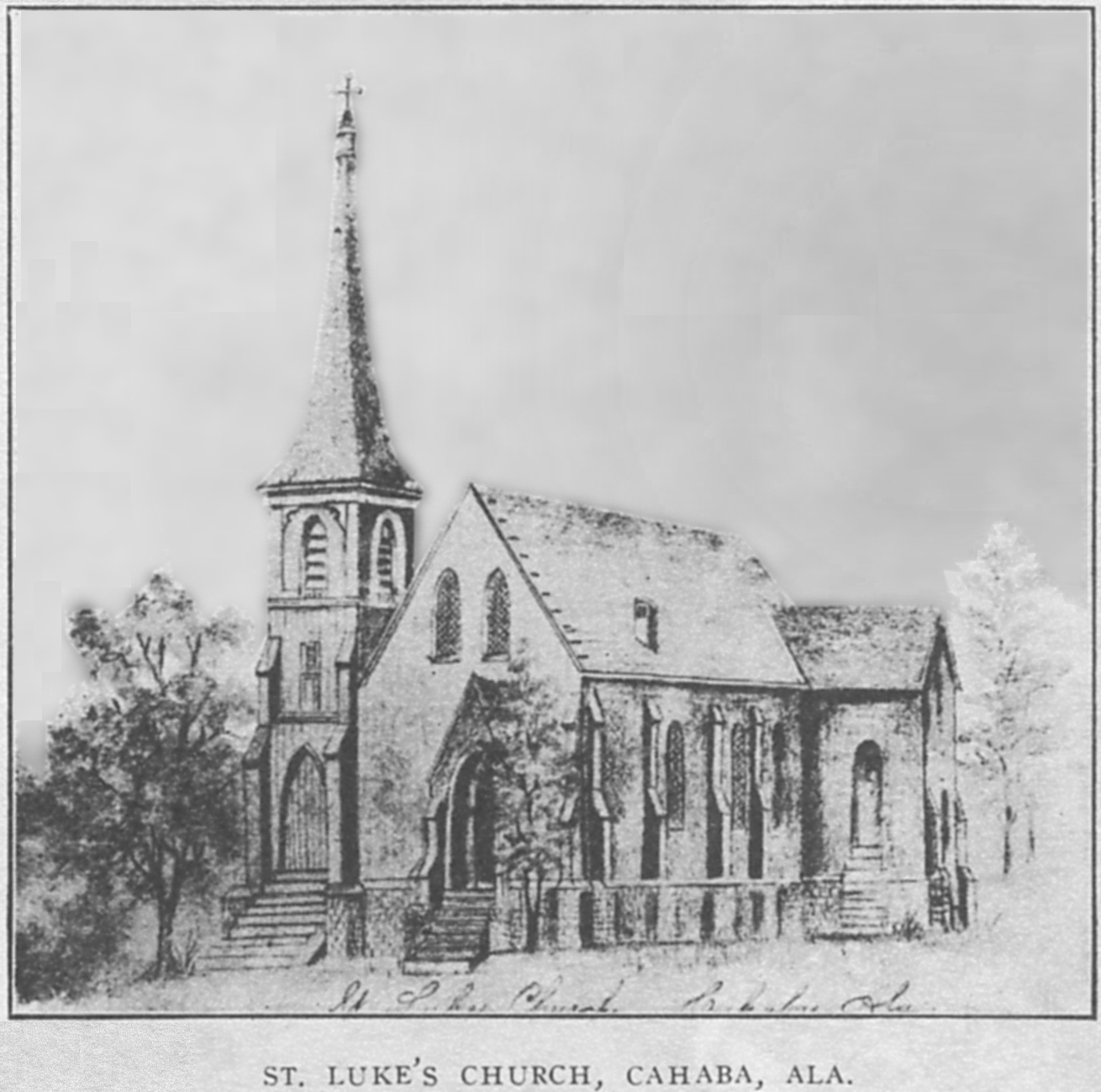- Cahaba, Alabama
Infobox nrhp
name = Cahaba
Cahawba
nrhp_type =

caption = St. Lukes Episcopal Church, moved from Cahaba in the 1876 to Martin's Station, moved back to Cahaba in 2007.
lat_degrees =
lat_minutes =
lat_seconds =
lat_direction =
long_degrees =
long_minutes =
long_seconds =
long_direction =
location = coord|32|19|01|N|87|06|05|W
nearest_city = Selma,Alabama
area =
built =
architect =
architecture =
designated =
added = 1973cite web|title="Alabama: Dallas County"|work="National Register of Historic Places"|url=http://www.nationalregisterofhistoricplaces.com/AL/Dallas/state.html|accessdate=2008-01-07]
established =
visitation_num =
visitation_year =
refnum = 73000341
mpsub =
governing_body = Alabama Historical CommissionCahaba, also spelled Cahawba, was the first permanent state
capital ofAlabama from 1820 to 1825.cite web|title="Old Cahawba, Alabama's first state capital, 1820 to 1826"|work="Old Cahawba: A Cahawba Advisory Committee Project"|url=http://www.cahawba.com/|accessdate=2008-01-07] It is now aghost town and state historic site and is located in Dallas County, near the city of Selma.Harris, W. Stuart. "Dead towns of Alabama", pages 66-67. Tuscaloosa : University of Alabama Press, 1977. ISBN 0585265631]History
Capital
Cahaba had its beginnings as an undeveloped town site at the confluence of the Alabama and Cahaba Rivers. At the old territorial capital of St. Stephens, a commission was formed on 13 February 1818 to select the site for Alabama's state capital. Cahaba was the site chosen and was approved on 21 November 1818. Due to the future capital being nothing more than wilderness, Alabama's constitutional convention was forced to find temporary accommodations in Huntsville until a statehouse could be built. Governor
William Wyatt Bibb reported in October of 1819 that the town had been laid out and that lots would be auctioned to the highest bidders. The town was planned on a grid system with streets running north and south named for trees and those running east and west named for famous men. The new statehouse was a two-story brick structure, measuring convert|40|ft|m|0 wide by convert|58|ft|m|0 long. By 1820 Cahaba had become a functioning state capital. Cahaba's low elevation at the confluence of two large rivers gave it a reputation for flooding and having an unhealthy atmosphere. A major flood struck the town in 1825, causing a portion of the statehouse to collapse. People who were opposed to the capital's location at Cahaba used this as an argument for moving the capital to Tuscaloosa, which was approved by the legislature in January of 1826.cite web|title="Capitals of Alabama"|work="Alabama Department of Archives and History"|url=http://www.archives.state.al.us/capital/capitals.html|accessdate=2008-01-07]Antebellum
The town would remain the county seat of Dallas County for several more decades.cite web|title="Dallas County Historical Markers"|work="Alabama Department of Archives and History"|url=http://www.archives.state.al.us/markers/idallas.html|accessdate=2008-01-07] The town eventually recovered from losing the capital and reestablished itself as a social and commercial center. Cahaba, centered in the fertile "Black Belt", became a major distribution point for
cotton shipped down the Alabama River to the port of Mobile. The addition of arailroad line in 1859 triggered a building boom in the town of Cahaba. On the eve of theAmerican Civil War , more than 3,000 people called Cahaba home.During the Civil War, the Confederate government seized Cahaba's railroad, reappropriated the iron rails to extend another nearby railroad of military importance. A large cotton warehouse on the riverbank along Arch Street was stockaded for use as a prison, known as Castle Morgan from 1863 to 1865. In February 1865 another flood inundated the town, causing much additional hardship for the roughly 3000 Union soldiers held in the prison, and for the town's citizens. Confederate General
Nathan Bedford Forest and Union GeneralJames H. Wilson discussed an exchange of prisoners, captured during theBattle of Selma , in Cahaba at the Crocheron mansion.Postbellum
In 1866 the county seat was moved to nearby
Selma, Alabama . Businesses and families followed. Within 10 years, even many of the houses and churches were being dismantled and moved away. During Reconstruction, the vacant courthouse became a meeting place for freedmen seeking new political power. A new rural community of former slave families replaced the old urban center. These families turned the vacant town blocks into fields and garden plots. Soon, even this community largely disappeared. Prior to the turn of the century a former slave purchased most of the old town site for $500. He had the abandoned buildings demolished for their building materials and shipped bysteamboat to Mobile and Selma. By 1903 most of Cahaba's buildings were gone, only a handful of structures survived past 1930.cite web|title="Old Cahawba"|work="Alabama Historical Commission"|url=http://www.preserveala.org/oldcahawba.aspx?sm=g_l|accessdate=2008-01-07]Modern
Although the area is no longer inhabited, the
Alabama Historical Commission maintains Cahaba as a state historic site and as an important archaeological site. It was added to theNational Register of Historic Places in 1973. Visitors to this park can still see many of the abandoned streets, cemeteries, and ruins of this former state capital.Gallery

References
Bibliography
Fry, Anna M. Gayle. "Memories of Old Cahaba". Nashville, Tenn: Publishing House of the Methodist Episcopal Church, South, 1908.
External links
* [http://www.selmaalabama.com/index.php?option=content&task=view&id=27&Itemid=59 Old Cahawba]
* [http://www.preserveala.org Alabama Historical Commission]
* [http://www.cahawba.com Cahawba Advisory Committee]
* Meador, Daniel, [http://www.vqronline.org/articles/2002/winter/meador-riding/ "Riding Over the Past?"] , "Virginia Quarterly Review", Winter 2002.
Wikimedia Foundation. 2010.
